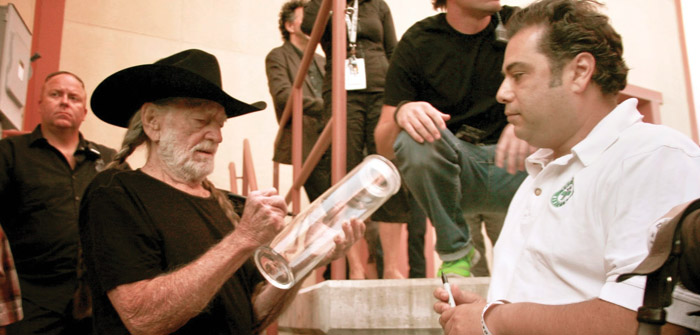July 1, 2015 was an historic day for Oregon residents as recreational marijuana became legal. Marijuana proponents and businesses catering to them rejoiced at both the end of marijuana prohibition in the state and the business opportunities awaiting entrepreneurs. Deschutes County medical marijuana dispensaries, growers and other secondary businesses all look forward to the economic potential of the legalization.
Last November, Oregon residents voted in favor of Measure 91, also known as the Control, Regulation and Taxation of Marijuana and Industrial Hemp Act, making Oregon the fourth state to allow recreational marijuana. The passing, by a 57 percent yes vote, came on the heels of a flurry of activity in 2012 that saw Washington and Colorado vote to allow recreational marijuana, while regon’s Measure 80 get shot down. Oregon proponents also tried in 1986 with Measure 5.
“I think this is a great day for Oregon and the United States,” says marijuana user Jeremiah Jones. “It was time to end the prohibition. The people called for it.”
Measure 91 allows for the private use and cultivation of marijuana for adults 21 and over, while stressing the public consumption of cannabis still being illegal. The law limits the amount you can possess to eight ounces in the home and one ounce outside the home, and caps the ability to grow up to four plants per household. Driving under the influence of marijuana remains illegal as does crossing state lines with it including to Washington.
The real benefits for the State of Oregon will come in the form of taxation and regulation. While the State of Oregon’s Legislative Revenue Office estimates $16 million in tax revenue for the first year and $46.6 million for the first full biennium, some studies have placed those figures at up to $38.5 million and $78.7 million. Harvard Economics Professor Dr. Jeffery Miron estimates a $71 million public safety savings in the first year alone.
The Measure directed the Oregon Liquor Control Commission (OLCC) to create and regulate the commercial cannabis cultivators, the process and retailers. Most local governments have been scrambling to put rules in place since last November’s election.
The OLCC is mandated to create applications and regulatory structure needed to implement the initiative by January 1, 2016 and begin taking applications for retail cannabis businesses licenses. However, pressure for temporary sales grew after the OLCC said it would not be ready to license retailers until the second half of 2016. In response, the Oregon State Legislature just passed SB 460 and sent it to Governor Kate Brown for signature. The bill allows for medical dispensaries to sell to adults up to one quarter ounce of dried marijuana and four immature plants per day.
The confusion of what is legal, along with public misconceptions, seem to be the current order of the day. In addition, the divide between liberal and conservative viewpoints adds to the uncertainty. While Deschutes County residents barely swayed toward Measure 91, with 51.5 percent approval, Bend currently has over a dozen medical marijuana dispensaries.
A source of contention lies in the regulation of the marijuana businesses already open; mainly the medical dispensaries. It came to a head on July 1, as one of Bend’s more than a dozen medical marijuana shops gave away free joints to celebrate the occasion. The OLCC shut the event down and reminded the dispensary the new rules don’t apply to them, as they are regulated by the Oregon Health Authority. Both sides admitted confusion on the issue.
Deschutes County received seventeen applications when the State of Oregon began issuing dispensaries in March 2014. The Oregon Medical Marijuana Program (OMMP) states there are 3,696 patients in Deschutes County.
For the most part, the medical marijuana dispensaries have taken care to follow the mandated rules placed upon them, while contributing to the economic viability of Deschutes County. In addition, most shops maintain a sense of community and civic responsibility.
“Every month I pick someone from our community and give them free medicine for the entire month,” says David Ordonez of Top Shelf Medicine in Bend. “We sponsor Neighborhood Impact (through) an ongoing food drive and have donated over 570 pounds since the dispensary opened.”
Top Shelf Medicine opened as a medical marijuana dispensary in December 2014. They specialize in high THC (tetrahydrocannabinol, an active ingredient in marijuana) levels and award-winning custom breeding of marijuana. They offer up to 50 different strains of flower and over 100 products including edibles. Like most dispensaries, Top Shelf Medicine hopes to turn to recreational sales once allowed.
“We feel that it will be the same process as getting our medical license, just a lot of hoops to jump through,” explains Ordonez.
Another secondary industry experiencing growth with the new laws are the marijuana farmers. Growers are tapping into Central Oregon’s rich history in farming to produce the necessary plants to meet demand.
“Oregon will have one of the best recreational programs in the country,” says Rustin Kluge of CannaTea. “Alfalfa will be the next Napa, but for marijuana. The weather, climate, sun and soil are perfect.”
CannaTea has one of the largest grow operations in the state with twenty acres in Alfalfa. They currently only grow for medical patients, but will obtain a recreational license when available. They plan on growing for their brand of cannabis tea in October. Their farm is one of the first fully organic, eco-friendly operations in the country. The cannabis beverage company currently has twenty employees, 90 percent of those are locals and will double that number by the end of the year.
“We are trying to build this as an industry,” says Kluge. “There are ten marijuana farms within five miles of us.”
In an effort to help growers and shops maintain a level of consistency and quality control two marijuana testing facilities, CannAlytical Research and Cascadia Labs, have opened in Bend. Both facilities test all types of cannabis and related products, such as edibles and extracts. They are testing for potency in regards to THC level and CBD (Cannabidiol). CBD is considered to have more medical applications than THC. The labs test for pesticide usage, yeast and mold.
One lesser-known aspect of Measure 91, lost in the discussions, is the ability of Oregon farmers to grow industrial hemp and hemp seeds. The non-potent cousin of marijuana has been a hugely underutilized natural resource due to its Schedule 1 drug classification. While the Oregon Department of Agriculture has had calls from interested Central Oregon farmers, no applications have been received. OSU researchers and farmers question whether Central Oregon has the climate to support hemp’s need for consistently warm temperatures and longer growing season. However, the possibility exists in warmer areas such as Madras and Warm Springs.
(Photo above: David Ordonez of Top Shelf Medicine meets Willie Nelson | Photo Courtesy of Top Shelf Medicine)





